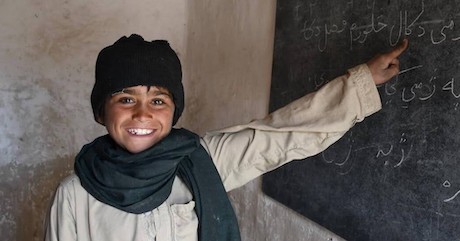Food shortages, prolonged conflicts, natural disasters and the socio-economic impacts of COVID-19 continue to threaten the health, safety and well-being of children across South Asia.
The coronavirus pandemic hit the region particularly hard, exacerbating ongoing challenges and bringing on new ones. Inflation is leading to increased food insecurity. Meanwhile, weather-related disasters such as cyclones and monsoon floods continue to disrupt the lives of tens of millions of people each year.
The current humanitarian action plan for the region accounts for a number of challenges across all program areas: health, education, nutrition, child protection and water, sanitation and hygiene (WASH).
3-year-old Mohammed, a Rohingya refugee in Bangladesh, recovered from severe acute malnutrition after receiving treatment at a UNICEF-supported center. © UNICEF/UN0632355/Map
Here are a few highlights from ongoing efforts in specific countries.
Afghanistan: supporting education, nutrition and mental health
Political and socio-economic developments in Afghanistan in 2021 brought further turmoil to a country that has experienced four decades of prolonged conflict, recurrent natural disasters, chronic poverty and disease outbreaks — including the devastating effects of COVID-19.
Schools in Afghanistan re-opened in March, but girls in grades 7 through 12 were prevented from returning to class. Through the Let Us Learn program, UNICEF and partners continue to build out community-based learning opportunities for underserved students in remote communities. Other forms of support — learning materials and teacher training — reached 7 million children last year.
Another priority for UNICEF in the country is to provide mental health services and psychosocial support for children in need. Those prgrams reached 4 million children with services last year.
Other program goals for the country include goal admitting over a million children suffering from severe acute malnutrition (SAM) for treatment and creating sufficient access to clean water for 11 million people. UNICEF is also expanding its Explosive Ordnance Risk Education (EORE) program — a critical initiative for a country that accounts for nearly 90 percent of the world’s child casualties related to encounters with the remnants of war.
Bangladesh: helping Rohingya refugees
UNICEF has focused its support on the nearly 1 million Rohingya children and families who have fled to Bangladesh from Myanmar and are currently living in the world’s largest refugee settlement — and their host communities.
Throughout the pandemic, UNICEF has been working with partners to repair and reconstruct infrastructure that is critical for education, health and child protection. Emergency response teams provide ongoing support to refugees impacted by recent fires and floods.
India: supporting the pandemic response
Few countries have been hit as hard as India by the COVID-19 pandemic. A deadly surge in cases in 2021 placed an enormous strain on health and critical care facilities across the country, leaving vulnerable families paying a steep price.
A mother and child in Kantivaas Village, Banaskantha, Gujarat, India, one of many vulnerable communities where UNICEF and partners are providing support services. © UNICEF/UN0377921/Panjwani
UNICEF and partners have been supporting India’s pandemic response by delivering medical supplies and critical equipment and helping to train healthcare facility staff and community health workers in infection prevention and control. Over 40 million children and women accessed health care services in UNICEF-supported facilities last year.
UNICEF has also expanded its program in gender-based violence risk mitigation, prevention and response, reaching over a million women, girls and boys.
Sri Lanka: easing the impacts of an economic crisis
A shortage of foreign currency is preventing Sri Lanka from being able to import essential goods like food, medicine, and oil, and is leading to the country’s worst economic crisis in decades. With inflation above 25 percent, the rising price of key commodities is affecting families’ ability to meet their basic needs.
As families struggle to find enough food, public transportation services have been cut, leaving children unable to go to school or receive their regular school meals. Children who are out of school and whose families are being pushed further into poverty are increasingly vulnerable to child labor and other rights violations. It is likely that all 6 million children in the country will be affected in some way by this crisis.
Jithmini, 17, a student whose school outside Colombo, Sri Lanka, closed before end of term. Transportation to school by van had become prohibitively expensive due to rising fuel prices. “I am worried about what will happen next,” Jithini said. © UNICEF Sri Lanka
In 2022, UNICEF is focusing on delivering support across all major program areas. Priorities include providing:
- maternity and neonatal kits to protect the health of mothers and their babies
- micronutrients to prevent malnutrition in children ages 6 months to 2 years
- learning supplies and catch-up learning support for students in rural communities
Learn more about UNICEF’s work in the South Asia region. Support UNICEF’s mission to save and protect vulnerable children and families. Donate today.
Top photo: A child points to a blackboard at a UNICEF-supported community-based education center in Kandahar city, Afghanistan. © UNICEF/UN0595100/Karimi
